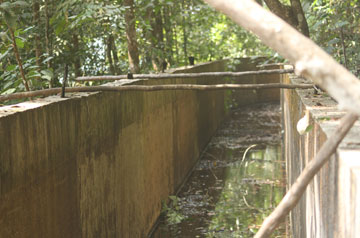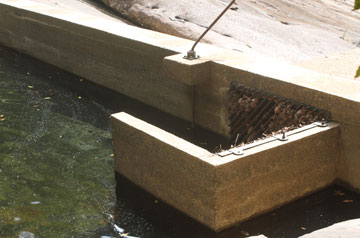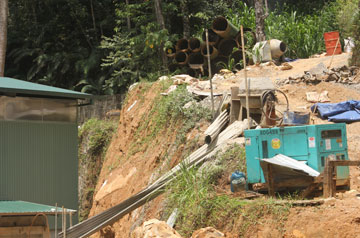|
Sri Pada mini hydro project:
Willful destruction ?
by Sureshni Pilapitiya
The mini- hydro project which is nearing completion in the protected
Sri Pada reserve, a UNESCO World Heritage Site is flouting environmental
laws and causing immense environmental damage.

The water flow of one of the seven waterfalls has drastically
reduced |

Construction work going on apace |

The dams obstructing the water flow |

Machinery used in the construction of the dam |
Construction work is going on apace blocking the water which flowed
to two of the seven waterfalls of Ella Hatha.
Well-known environmental lawyer and environmentalist, Jagath
Gunewardena said "Many were of the view that the Sinharaja forest had
the largest bio-diversity, this is not so, it is Sri Pada which has a
larger bio diversity.
Environmental laws
This project is highly politicized and is damaging the environment,
there is no two words about that. At one time they halted the project
but work on it began once again with the presidential elections".
He said the Wildlife Department does not have any authority to
approve projects that were illegal. It is high time that a full scale
investigation is carried out as to how government officials approved a
project that was illegal and flouted environmental laws. This area is a
nature reserve and comes under the Fauna and Flora Act. According to
section 5 (A) any one who enters this area has to get permission from
Wild life department. And such permission can be only given for research
and study of wildlife and for any official task.
According to Section 3, Section 6 (A) it was illegal to carry out
construction activities within a nature reserve. The authorities should
take action and look into this matter as soon as possible or else Sri
Lanka will lose one of it's greatest treasures.
Meanwhile, when members of The Rain Forest Protectors of Sri Lanka
went there last, most of the project work was complete. This month they
will test the effect of the project.
A dam is being built at Waterfall number 2 and the water is to be
diverted to a turbine. The Rain Forest Protectors of Sri Lanka were
trying their level best to put an end to this environmental damage and
calling for a halt to the project but so far they have been
unsuccessful.
Their view is that if this project goes ahead, two of the waterfalls
will completely run dry. "It is shocking to see construction work going
on apace in a protected nature reserve. Due to this project getting off
the ground, irreversible damage has already been done to the protected
Sri Pada sanctuary and World Heritage Site", they said.
In addition to dams being built within the reserve, large trees have
been felled to clear for heavy pipelines. This is a violation of the
Flora and Fauna Protection Ordinance 1937 (amended 2009) and Forest
Ordinance 1908 .
The Samanala Adaviya consisting of 12, 979 hectares, was declared as
a nature reserve by gazette notification on September 7, 2007 and is
protected by the Flora and Fauna Protection Ordinance (FFPO).
Section 3 and 6 of the Act forbids any development activity in a
nature reserve such as construction of permanent or temporary
structures, deforestation, removal of plants, destroy fauna and flora or
construction of roads.
Samanala Adaviya Nature Reserve (SANR) is one of the five nature
reserves in the country and is the richest in bio - diversity with the
highest number of endemic species.
Because of it's exceptional importance, UNESCO declared SANR and the
central hills in the country as a natural world heritage site in 2010.
Moreover, the destruction of this habitat will affect endangered
species such as Sri the Lanka Blue Magpie and the Sri Lankan Green Pit
Viper which inhabit this wilderness as well.
The Sunday Observer spoke to members of the Rain Forest Protectors of
Sri Lanka . They said "The power plant has been constructed inside the
sanctuary. None of these activities can be carried out without the
permission of the Department of Wild Life Conservation (DWLC). You can't
even put a backhoe without the permission of UNESCO. But backhoes can be
seen coming in and out of the sanctuary.
The bio diversity of the sanctuary is more than what Sinharaja has.
These days it is difficult to find animals which we saw earlier.
They are building a dam on top of a second dam. A waterfall should
consist of at least forty percent of water. Water should be there even
during a drought. A waterfall should be in full flow but now the water
flow has drastically reduced.
This is the time when the water falls are in full spate but this is
not so here.. If the dam is opened, the waterfall will lose all the
water. It will have a negative effect on the natural habitat and on wild
animals frequenting the area. Most animals in the area are species
endemic to Sri Lanka. When water is diverted to the power plant the
water will flow to a kilometre or more.It is through this process that
the waterfall will get the water as well.
Sunlight
A rain forest is identified by the amount of rain it gets for a year.
The growth of trees in a rain forest are known as 'the four canopies''.
Trees in these forests grow in a perticular way. This is not a normal
forest. It doesn't get enough sunlight. The water quantity directly
falls to the ground. With trees being indiscriminately chopped off, it
is bound to cause landslides and earthslips. Two waterfalls of the seven
were bound to 'vanish' if the power plant is constructed".
Jagath Gunawardene, said, " Endangered fish such as the Lipstick Goby
(Sciecyoeter Jonklassi) and the Stone Goby (Sysiopus Helei ) being
harmed .It is a problem for their breeding and habitat. The main issue
is not the habitat or the species, though they are important, it is the
concern of the legal issues which are highlighted''.
Heritage sites
The turbines will send water which will include chemicals and it will
affect animals and people. Then it will be a mechanical disaster. This
project commenced way back in 2000- 2003 and was still continuing. If
Sripada is a UNESCO Heritage site and is protected, my question is 'how
do these things happen ? There is a certain code of rights regarding
Wildlife and Heritage sites. Since Sri Pada is a UNESCO heritage site
and we violate the laws of a heritage site, we are bound to lose the
UNESCO protection, it will be a pity and shame. It will affect the
tourism industry too, since there will be a decrease in the number of
tourist arrivals once the site loses its beauty".
The DWLC owns the land. There are two turbines and generators also.
The purpose plant is to provide electricity to houses in the vicinity
but all this is being done without considering the dire consequences and
the environmental impact. It is true we need electricity and we have our
wants and desires but it should not be at the expense of the
environment.
St. Clare's
For instance take the St. Clare's waterfall- It was the most
beautiful waterfall in Sri Lanka but due to construction of hydro power
projects and diversion of water, it's ruined now and has lost its former
glory.
"We need modern technology but not at the expense of ruining nature,
the Rain Forest Protectors said. When the Sunday Observer spoke to the
DWLC, a spokesperson spoke on behalf of the Director General H D
Rathnayake who was not available for comment and said that since the
need for electricity was increasing and the construction of the power
project was to fulfil this requirement. However, she admitted the it had
an impact on the environment and was against the law for protected
areas. "But since it was considered a national requirement, it was
allowed. If there was a huge threat to the environment it might be
stopped", she said. |

